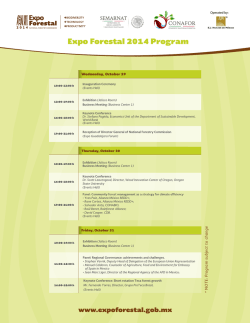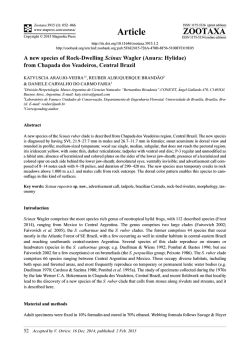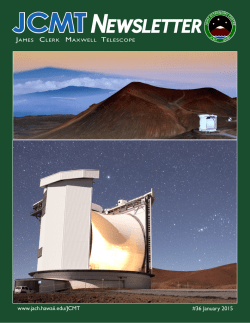
Preview - Magnolia Press
Zootaxa 3914 (3): 301–317 www.mapress.com /zootaxa / Copyright © 2015 Magnolia Press Article ISSN 1175-5326 (print edition) ZOOTAXA ISSN 1175-5334 (online edition) http://dx.doi.org/10.11646/zootaxa.3914.3.4 http://zoobank.org/urn:lsid:zoobank.org:pub:C83CDA14-8528-4E15-B5A5-ECE88621196B Two new species of Eleutherodactylus (subgenus Syrrhophus) from western Mexico JACOBO REYES-VELASCO1,2,6, IVAN AHUMADA-CARRILLO3, TIMOTHY R. BURKHARDT4 & THOMAS J. DEVITT5 1 Department of Biology, University of Texas at Arlington, 501 S. Nedderman Drive 337 Life Science. Arlington, TX 76010-0498 Entorno Biotico A.C., Simon Bolivar #145, San Pablo. Colima, Colima, Mexico. 28000. 3 Centro Universitario de Ciencias Biológicas y Agropecuarias, Carretera a Nogales Km. 15.5. Las Agujas, Nextipac, Zapopan, Jalisco, Mexico 4 10150 West Rudasill Rd.Tucson, AZ 85743, USA 5 Department of Integrative Biology, The University of Texas at Austin, Austin, TX 78712, USA 6 Corresponding author. E-mail: [email protected] 2 Abstract We describe two new species of Eleutherodactylus, subgenus Syrrhophus, from two separate mountain ranges in western Mexico. Eleutherodactylus grunwaldi sp. nov. inhabits the Sierra de Manantlán in Colima and Jalisco from 1300 to 2200 m, whereas E. wixarika sp. nov. is known from a single locality in the Sierra Huichola of northern Jalisco at 2400 m, but is probably more widespread. Eleutherodactylus grunwaldi is readily distinguishable from most members of mainland Syrrhophus by a combination of its large size, broad, truncate digital pads more than three times the narrowest part of the digit, and a black and green marbled color pattern. This species is saxicolous, inhabiting limestone outcrops, and has been found in caves during the dry season. Eleutherodactylus wixarika is a moderate sized species, most similar to E. teretistes, E. pallidus and E. modestus. It is distinguished from all other members of the subgenus by the combination a tuberculate, reddish dorsum, lack of compact lumbar glands, and expanded digital pads less than twice the width of the narrowest part of the digit. This species inhabits areas with secondary vegetation in pine forest. Males of both species call at night during the rainy season. The advertisement call of both species consists of a short, narrow band, pure-tone note organized into a discrete train at a rate of about six times per minute. Spectral and temporal acoustic properties differ between species. The subgenus Syrrhophus of the genus Eleutherodactylus is one of the most poorly studied groups of frogs in Mexico but probably one of the most diverse. Key words: Amphibia, Anura, Eleutherodactylidae, taxonomy, Terrarana, Tomodactylus, Jalisco, Colima, Sierra Manantlán, Sierra Huichol Resumen Describimos dos nuevas especies de Eleutherodactylus, subgenero Syrrhophus de dos sistemas montañosos diferentes en el occidente de México. Eleutherodactylus grunwaldi sp. nov. habita la Sierra de Manantlán en Colima y Jalisco, entre los 1300 y 2200 m, mientras que E. wixarika sp. nov. se conoce de una sola localidad a 2400 m en la Sierra Huichola en el norte de Jalisco, pero probablemente su distribución sea más amplia. Eleutherodactylus grunwaldi se distingue de los demás miembros del subgenero por su gran tamaño, almohadillas digitales muy expandidas y una coloración de manchas verdes y negras. Esta especie parece ser estrictamente saxícola, habitando rocas kársticas y también se ha recolectado en cuevas durante la temporada seca. Eleutherodactylus wixarika es una especie de tamaño mediano, más similar a E. teretistes, E. pallidus y E. modestus. Se distingue de todos los miembros del subgenero Syrrhophus por su piel áspera y una coloración dorsal rojiza, así como por no presentar glándulas lumbares y por tener almohadillas digitales que son menos de dos veces el ancho de la parte más angosta del dedo. Esta especie habita zonas de vegetación secundaria en bosque de pino. Los machos de ambas especies cantan durante la noche en la temporada de lluvias. El canto de ambas especies consiste en una nota corta de banda estrecha, organizada en pulsos discretos a un ritmo de seis veces por minuto. Las propie- Accepted by J. Padial: 11 Dec. 2014; published: 28 Jan. 2015 301 Several of the most important topographic features of Mexico converge in central-western Mexico; these include the Sierra Madre Occidental, the Trans-Mexican Volcanic Belt and the Pacific lowlands. The merging of these areas in the region has created a diverse assortment of unique habitats, and has made this region an important center of biodiversity, with many endemic species of vertebrates (e.g. Ceballos et al., 1995; Ceballos & Garcia, 1995; Peterson & Navarro, 2000). Many herpetological collections exist from the states of west central Mexico (Colima, Jalisco, Michoacán and Nayarit), but despite this, the herpetofauna of many areas in these states is still poorly known. We believe that future fieldwork in that area will result in new species discoveries, especially in isolated mountain ranges like the Sierra Cacoma and Sierra de Pihuamo in Jalisco, or the Sierra de Coalcomán in Michoacán. Frogs of the subgenus Syrrhophus are among the most diverse groups of anurans in Mexico, but because of the lack of attention that they have received, many species are still awaiting formal description (personal observation). Additional fieldwork in western Mexico and elsewhere will certainly result in the identification of new species of this group, and a careful revision of museum material along with molecular analyses will help us to better understand the species-level diversity and evolutionary history of the group. Conservation. Iron ore mining is an important economic activity in the mountains surrounding the Manantlán Biosphere Reserve, which is inhabited by E. grunwaldi. Mining activities have had a negative impact in the ecosystems and communities around the area; for example, a new open pit mine has already destroyed one of the only localities for the rare Manantlán Long-tailed Rattlesnake (Crotalus lannomi) (Reyes-Velasco, personal observation; see also Reyes-Velasco et al. 2010 for a discussion on the biological importance of the region). The Sierra Huichol in northern Jalisco has some of the last remains of old growth forest in the Sierra Madre Occidental, which now contains less than 0.65% of its original extent (Lammertink, 1996). Logging and the conversion of forest into agricultural fields are some of the biggest threats to the biodiversity of the region. The Wixárika or Huichol people, for whom E. wixarika is named, have been greatly affected by new economic activities in the area, including new roads and mining projects, logging, agriculture and the expansion of drug cartels in recent years (authors personal observation; Boni, Garibay, & McCall, 2014; González-Elizondo et al., 2012; Liffman, 2011; Tetreault & López, 2011). The culture and traditions of the Wixárika as well as the biodiversity of the area are increasingly threatened by human encroachment, and deserve protection if they are to persist in the long term. Acknowledgments We thank Christoph Grünwald and Jason Jones for their help in the field and generous donations of specimen to this project. We also thank Chris Rodriguez, Alexander Hermosillo, Gabriela Zamora-Silva and Ginny Weatherman for their help during fieldwork. We thank Jonathan A. Campbell, Eric N. Smith and Carl Franklin (UTA) for access to specimens under their care. We are also especially thankful to Jonathan A. Campbell for his assistance in reviewing this manuscript. Fieldwork was conducted under a collecting license issued to Oscar Flores by SEMARNAT (FAUT-0015). References Ahumada-Carrillo, I.T., River-Perez, N., Reyes-Velasco, J., Grünwald, C.I. & Jones, J.M. (2014) Notable Records of Amphibians and Reptiles from Colima, Nayarit, Jalisco, and Zacatecas, México. Herpetological Review, 45, 287–291. Arenas-Monroy, J.C., Carbajal-Márquez, R.A., García-Balderas, C.M., Grunwald, C.I. & Jones, J.M. (2012) ELEUTHERODACTYLUS VERRUCIPES (Bigear Chirping Frog). Geographic Distribution. Herpetological Review, 43, 439. Audacity Team (2014) Audacity®. Version 2.0.3. Audio editor and recorder. Available from: http://audacity.sourceforge.net/ (accessed 24 September 2014) Boni, A., Garibay, C. & McCall, M.K. (2014) Sustainable mining, indigenous rights and conservation: conflict and discourse in Wirikuta/Catorce, San Luis Potosi, Mexico. GeoJournal, 1–22. Ceballos, G. & Garcia, A. (1995) Conserving neotropical biodiversity: the role of dry forests in western Mexico. Conservation Biology, 9, 1349–1353. http://dx.doi.org/10.1046/j.1523-1739.1995.09061349.x Ceballos, G., Rodríguez, P. & Medellín, R.A. (1998) Assessing conservation priorities in megadiverse Mexico: mammalian diversity, endemicity, and endangerment. Ecological Applications, 8, 8–17. NEW SPECIES OF ELEUTHERODACTYLUS FROM MEXICO Zootaxa 3914 (3) © 2015 Magnolia Press · 315 http://dx.doi.org/10.1890/1051-0761(1998)008[0008:ACPIMM]2.0.CO;2 Cocroft, R.B. & Ryan, M.J. (1995) Patterns of advertisement call evolution in toads and chorus frogs. Animal Behaviour, 49, 283–303. http://dx.doi.org/10.1006/anbe.1995.0043 Cope, E.D. (1878) A New Genus of Cystignathidae from Texas. American Naturalist, 12, 252–253. Cox, C.L., Streicher, J.W., Sheehy III, C.M., Campbell, J.A. & Chippindale, P.T. (2012) Patterns of genetic differentiation among populations of Smilisca fodiens. Herpetologica, 68, 226–235. Dixon, J.R. (1957) Geographic Variation and Distribution of the Genus Tomodactylus in Mexico. Texas Journal of Science, 9, 379–409. Dixon, J.R. & Webb, R.G. (1966) A new Syrrhophus from Mexico (Amphibia: Leptodactylidae). Contributions in Science, Los Angeles County Museum, 102, 1–5. Duellman, W.E. (1958) A review of the frogs of the genus Syrrhophus in western Mexico. Occasional Papers of the Museum of Zoology, University of Michigan, 594, 1–24. Farr, W., Lavin Murcio, P.A. & Lazcano, D. (2007) New distributional records for amphibians and reptiles from the state of Tamaulipas, Mexico. Herpetological Review, 38, 226–233. Farr, W.L., Lazcano, D. & Lavín-Murcio, P.A. (2013) New Distributional Records for Amphibians and Reptiles from the State of Tamaulipas, México III. Herpetological Review, 44, 631–645. Fouquette, M. (1960) Call structure in frogs of the family Leptodactylidae. Texas Journal of Science, 12, 201–215. Frost, D.R., Grant, T., Faivovich, J., Bain, R.H., Haas, A., Haddad, C.F., De Sá, R.O., Channing, A., Wilkinson, M., Donnellan, S.C., Raxworthy, C.J., Campbell, J.A., Blotto, B.L., Moler, P., Drewes, R.C., Nussbaum, R.A., Lynch, J.D., Green, D.M. & Wheeler, W.C. (2006) The amphibian tree of life. Bulletin of the American Museum of Natural History, 297, 1–291. http://dx.doi.org/10.1206/0003-0090(2006)297[0001:TATOL]2.0.CO;2 Gerhardt, H.C. & Huber, F. (2002) Acoustic communication in insects and anurans: common problems and diverse solutions. University of Chicago Press, Chicago, 531 pp. González-Elizondo, M., González-Elizondo, M., González, L.R., Enríquez, I.L., Rentería, F.R. & Flores, J.T. (2012) Ecosystems and diversity of the Sierra Madre Occidental. USDA Forest Service Proceedings, RMRS-P-67, 204–211. Han, N.C., Muniandy, S.V. & Dayou, J. (2011) Acoustic classification of Australian anurans based on hybrid spectral-entropy approach. Applied Acoustics, 72, 639–645. Hedges, S.B. (1989) Evolution and biogeography of West Indian frogs of the genus Eleutherodactylus: slow-evolving loci and the major groups. Biogeography of the West Indies: past, present, and future, 305–370. Hedges, S.B., Duellman, W.E. & Heinicke, M.P. (2008) New World direct-developing frogs (Anura: Terrarana): Molecular phylogeny, classification, biogeography, and conservation. Zootaxa, 1737, 1–182. Heinicke, M.P., Duellman, W.E. & Hedges, S.B. (2007) Major Caribbean and Central American frog faunas originated by ancient oceanic dispersal. Proceedings of the National Academy of Sciences, 104, 10092–10097. http://dx.doi.org/10.1073/pnas.0611051104 Joglar, R.L. (1989) Phylogenetic relationships of the West Indian frogs of the genus Eleutherodactylus: a morphological analysis. In: Wood, C.A. (Ed.), Biogeography of the West Indies: past, present, and future. Sandhill Crane Press, Gainesville, Florida, pp. 371–408. Lemos Espinal, J.A. & Smith, H.M. (2007a) Anfibios y reptiles del estado de Chihuahua, México. UNAM, Mexico, 613 pp. Lemos Espinal, J.A. & Smith, H.M. (2007b) Anfibios y reptiles del estado de Coahuila, México. UNAM, Mexico, 550 pp. Lemos-Espinal, J.A. & Dixon, J.R. (2013) Amphibians and Reptiles of San Luis Potosí. Eagle Mountain Publishing, Eagle Mountain, Utah, 300 pp. Liffman, P.M. (2011) Huichol Territory and the Mexican Nation: Indigenous Ritual, Land Conflict, and Sovereignty Claims. University of Arizona Press, Tucson, Arizona, 296 pp. Lynch, J.D. (1970) A taxonomic revision of the leptodactylid frog genus Syrrhophus Cope. University of Kansas Publications Museum of Natural History, 20, 1–48. Lynch, J.D. (1971) Evolutionary Relationships, Osteology, and Zoogeography of Leptodactyloid Frogs. Miscellaneous Publications of the University of Kansas Museum of Natural History, 53, 1–246. Lynch, J.D. & Duellman, W.E. (1997) Frogs of the Genus Eleutherodactylus in Western Ecuador. The University of Kansas Natural History Museum Special Publications, 23, 1–252. Myers, G.S. (1962) The American Leptodactylid Frog Genera Eleutherodactylus, Hylodes (= Elosia), and Caudiverbera (= Calyptocephalus). Copeia, 195–202. http://dx.doi.org/10.2307/1439498 Penna, M. & Solís, R. (1996) Influence of burrow acoustics on sound reception by frogs Eupsophus (Leptodactylidae). Animal Behaviour, 51, 255–263. http://dx.doi.org/10.1006/anbe.1996.0026 Peterson, A. & Navarro, A. (2000) Western Mexico: a significant center of avian endemism and challenge for conservation action. Cotinga, 14, 42–46. Ponce-Campos, P., Huerta-Ortega, S.M., Heinze-Yothers, A. & Smith, H.M. (2003) Range extensions and variational notes on some amphibians and reptiles of Jalisco and Michoacan, Mexico. Bulletin of the Maryland Herpetological Society, 39, 1–7. 316 · Zootaxa 3914 (3) © 2015 Magnolia Press REYES-VELASCO ET AL. Reyes-Velasco, J., Grünwald, C.I., Jones, J.M. & Weatherman, G.N. (2010) Rediscovery of the rare Autlán long-tailed rattlesnake, Crotalus lannomi. Herpetological Review, 41, 19–25. Savage, J.M. (2002) The amphibians and reptiles of Costa Rica: a herpetofauna between two continents, between two seas. University of Chicago Press, Chicago, 934 pp. Schlaepfer, M.A. & Figeroa-Sandí, R. (1998) Female reciprocal calling in a Costa Rican leaf-litter frog, Eleutherodactylus podiciferus. Copeia, 1076–1080. Smith, H.M. & Taylor, E.H. (1948) An Annotated Checklist and Key to the Amphibia of Mexico. Bulletin of the United States National Museum, 194, 1–118. http://dx.doi.org/10.5479/si.03629236.194 Stewart, M.M. & Rand, A.S. (1991) Vocalizations and the defense of retreat sites by male and female frogs, Eleutherodactylus coqui. Copeia, 1013–1024. http://dx.doi.org/10.2307/1446096 Sueur, J., Aubin, T. & Simonis, C. (2008) Equipment review: seewave, a free modular tool for sound analysis and synthesis. Bioacoustics, 18, 213–226. http://dx.doi.org/10.1080/09524622.2008.9753600 Sueur, J., Farina, A., Gasc, A., Pieretti, N. & Pavoine, S. (2014) Acoustic Indices for Biodiversity Assessment and Landscape Investigation. Acta Acustica united with Acustica, 100, 772–781. http://dx.doi.org/10.3813/AAA.918757 Team, R.C. (2012) R: A language and environment for statistical computing. Vienna: R Foundation for Statistical Computing. Available: http://www.R-project.org (accessed 22 September 2014) Tetreault, D.V. & López, C.F.L. (2011) Jalisco: pueblos indígenas y regiones de alto valor biológico. Espiral, 18, 165–199. Webb, R.G. (1962) A new species of the frog (genus Tomodactylus) from western Mexico. University of Kansas Publications of the Museum of Natural History, 15, 175–181. APPENDIX 1. Specimens examined. Eleutherodactylus grunwaldi—Mexico: Colima: 3.5 km ESE of El Sauz, on road to El Terrero, Municipality of Minatitlán, 1,329 m (MZFC 27472); dirt road between El Sauz and El Terrero, Municipality of Minatitlán, 1,300–1,900 m (MZFC 27467–27471 & 27473–27475); 6.7 km SW of El Sauz, on road to El Terrero (MZFC 27484); Mexico: Jalisco: Grutas de Toxín, Municipality of Toliman, 770m (JRV-230). Eleutherodactylus wixarika—Mexico: Jalisco: Bajío de los Amoles, Municipality of Mexquitic, 2,460 m. (MZFC 2747727479). Additional specimens examined at UTA: Eleuterodactylus angustidigitorum: JAC 24912, JAC 26977. E. cystignathoides: JAC 30000–30001, JHM 1390–1394. E. dennisi: UTAA 59516–59521. E. dilatus: UTAA 4017–4020, 4023–4024, 5269, 5276–5279. E. grandis: UTAA 56845. E. guttilatus: JAC 29603, 29834, 29843. E. leprus: JAC 30833–30835, 30849. E. longipes: UTAA 59421–59422. E. marnockii: JHM 1427–1429. E. modestus: JAC 28295, 29117, 30498, 30499, 30518, 30519, 30631. E. nitidus: ENS 9557, JAC 26947. E. nitidus nitidus: JAC 27256-27276. E. nitidus orarius: JAC 29107, 30500, 30501, 30517, 30625. E. nitidus petersi: JAC 27237, 28612. E. pipilans: JAC 30813. E. sp: ENS 9931, JAC 27707, 30723, 30725–30728, 26663, 30840, 30841, TDH 1530–1531. Additional specimens examined at MZFC: Eleutherodactylus modestus: MZFC 26888–26889. E. nivicolimae: MZFC 26889, 26882–26887, 26905–26908. E. sp: MZFC 26893, 26896, 26898, 27476. NEW SPECIES OF ELEUTHERODACTYLUS FROM MEXICO Zootaxa 3914 (3) © 2015 Magnolia Press · 317
© Copyright 2025



